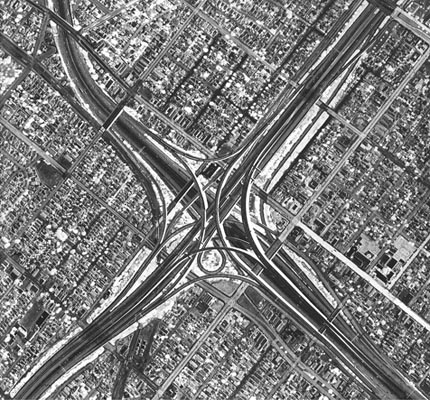Oblivion: David Maisel
At the Santa Barbara Museum of Art. Shows through April 27.

Anyone who has ever tried to negotiate the sprawl of Los Angeles has likely encountered the sense of fear and trepidation such an undertaking solicits. The relentless stretches of freeways, the entangled overpasses, the overwhelming mass of it all-L.A. is a city whose lifeline is fed through cold avenues of concrete. Exit ramps hurl commuters into anonymous suburbs and amorphous strip malls that seem to duplicate themselves at will. Presumably, living and surging among it all are the millions of inhabitants for whom this mess serves as home.
In Oblivion, David Maisel’s current exhibition at the Santa Barbara Museum of Art, the San Francisco-based photographer offers eerie aerial views of California’s southern megalopolis. There’s nothing new in seeing the city from a bird’s-eye perspective, yet Maisel’s images are not commonplace. By reversing the tones of his large-scale photographs, the artist achieves negative prints that enhance the sense of relentless urban sprawl and impart these vistas with an apocalyptic feel. From such a distance, the city appears inhuman, depopulated.
Streets, avenues, and boulevards form a geometric framework within which houses and businesses nestle. Modern-day tract complexes twist and swirl as they wrap themselves around undulating topography. High-rise buildings jut from their planar surrounds as if with defiance, their forms underlined by the disturbing glow imparted by the tonal reverse of the shadows. And freeways run through it all like black veins poisoned by excess. These are anatomical studies of a city unlike any other.
Maisel has previously used his aerial vantage point to observe the surrounds of the Great Salt Lake, the Owens Valley, and the environmental scarring caused by mining. From such a remote and all-encompassing vantage point, the viewer can appreciate the full impact that modern society has had upon the land that sustains and nourishes it. The resulting imagery is both scary and serene. Oblivion takes Maisel’s vision one step further. This time it is our own suburbs and streets that lay thousands of feet below his lens. And this time, though we know the landscape so well, we are seemingly nowhere to be found.



